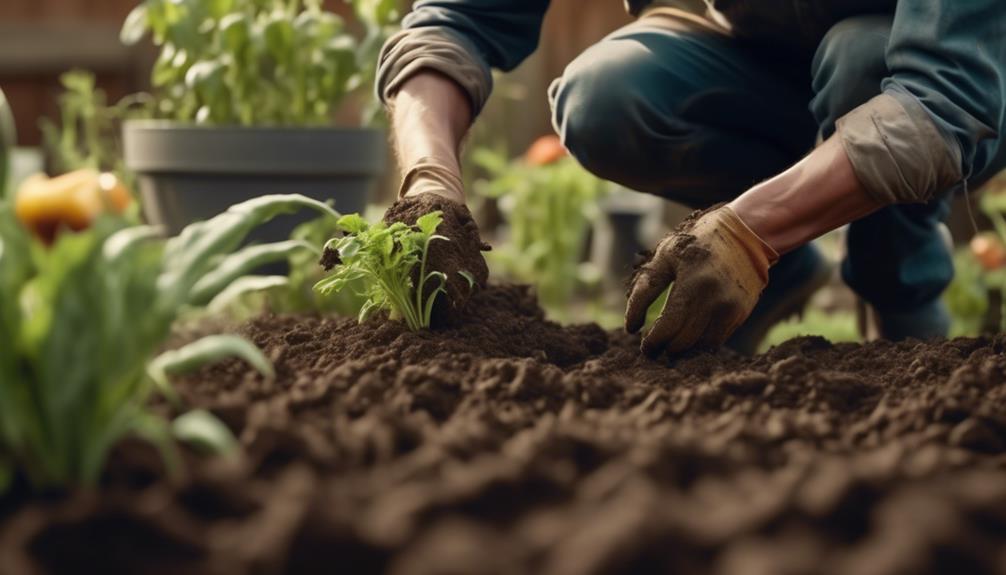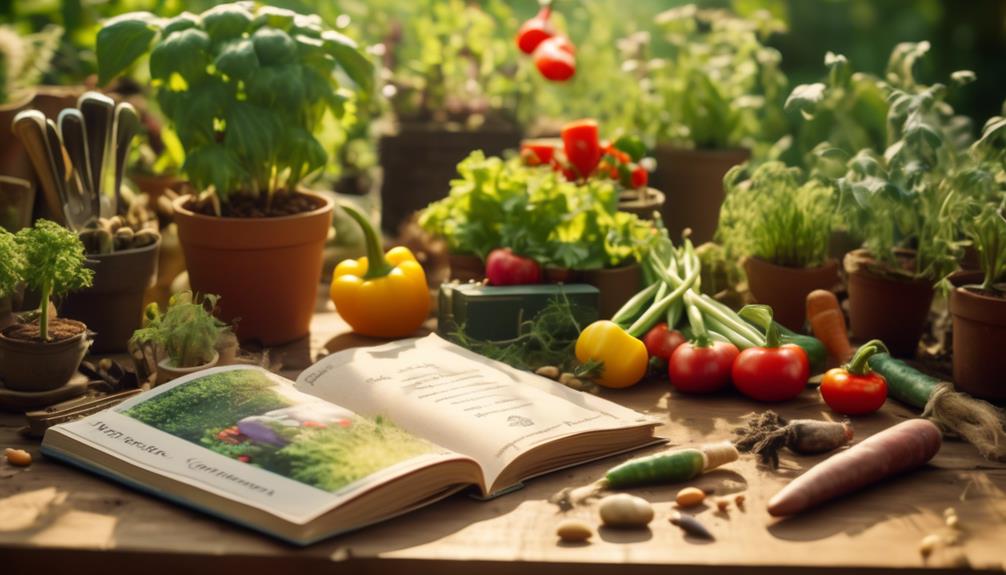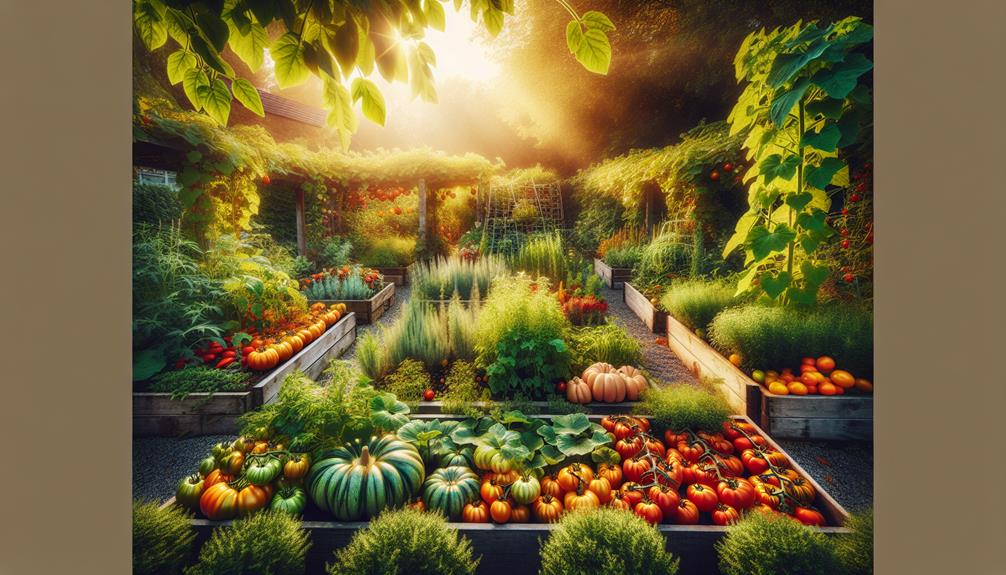Are you tired of relying on the grocery store for your fresh produce?
Imagine picking a ripe tomato straight from your own backyard and savoring its juicy goodness.
Picture the satisfaction of serving a meal to your family, knowing that every ingredient was grown with your own hands.
Whether you're a beginner or have some gardening experience, the art of homestead gardening holds the key to a more sustainable and fulfilling lifestyle.
But where do you begin? How do you navigate the complexities of soil, pests, and plant care?
In this discussion, we will uncover the secrets to mastering the art of homestead gardening, equipping you with the knowledge and skills to create a thriving garden that will nourish both your body and soul.
Get ready to embark on a journey of growth and abundance – your own homestead garden awaits.
Key Takeaways
- Proper planning and preparation are essential for successful homestead gardening. Consider factors such as water, sunlight, nutrients, and climate when setting up your garden.
- Avoid common mistakes made by first-time gardeners, such as planting in the wrong climate or shady spots, using poor soil, overcrowding plants, or planting incompatible species together.
- Expand beyond container gardening by exploring alternatives like vertical gardens, hydroponic setups, or joining a community garden for more space and experienced guidance.
- Soil preparation is crucial for homestead gardens. Ensure your soil has the right components, such as vermiculite, compost, and peat moss. Consider soil testing to assess its quality and make necessary adjustments.
Planning and Preparation
To ensure the success of your homestead garden, thorough planning and meticulous preparation are crucial steps that can't be overlooked. When it comes to designing layouts and selecting vegetables, it's important to consider factors such as water, oxygen, sunlight, and nutrients. Research recommended vegetables for your region and consult local extension offices for assistance and advice.
Use plant hardiness and heat zone maps to determine suitable plants and experiment with a variety of seeds and seedlings to identify successful plants. Start small and focus on a manageable garden, taking into account the days to maturity and growing season.
Expanding Beyond Containers
Consider the challenges of container gardening and explore alternative methods to expand your homestead garden beyond pots and limited space.
While container gardening is a great option for limited spaces, there are other innovative ways to maximize your gardening potential. One option is vertical gardening, which involves growing plants on vertically inclined structures such as trellises, fences, or walls. This method allows you to utilize vertical space and increase your planting area.
Another alternative is hydroponic setups, which involve growing plants in nutrient-rich water without soil. Hydroponics allows for precise control over growing conditions and can be done indoors or outdoors.
Soil Preparation

Expanding beyond containers and exploring alternative methods for maximizing your homestead garden's potential, it's essential to understand the importance of soil preparation. A well-prepared soil lays the foundation for healthy and vibrant plants, ensuring maximum yield and flavor.
Here are some key points to consider when preparing your soil:
- Soil testing: Before you start, it's crucial to know the nutrient composition of your soil. Soil testing can reveal deficiencies and help you choose the right fertilizers to amend the soil accordingly.
- Fertilizer options: Depending on your soil test results, you can choose from various fertilizer options such as bone meal, blood meal, or seaweed meal. These options provide essential nutrients for plant growth and can significantly enhance your garden's productivity.
Companion Planting
Companion planting is a strategic gardening technique that involves planting certain vegetables together to promote growth, deter pests, and maximize the overall health and productivity of your homestead garden.
There are numerous benefits to companion planting. For instance, planting taller plants like corn or sunflowers alongside shorter plants like lettuce or spinach can provide shade and protect them from excessive heat.
Additionally, certain plants, such as marigolds, garlic, or basil, can help repel pests when planted around vulnerable plants like tomatoes. Another example is avoiding planting tomatoes with brassica vegetables, as they can hinder each other's growth.
Companion planting allows for the efficient use of space, creates a diverse and balanced ecosystem, and helps plants thrive in a symbiotic relationship.
Tips for Success and Learning

To ensure success and continuous learning in your homestead garden, it's essential to implement effective strategies and follow expert advice. Here are some tips to help you maximize yields and maintain your garden:
- Garden Maintenance:
- Regularly weed your garden to prevent nutrient theft and stunted growth.
- Use natural remedies and hand removal for organic gardening.
- Attract beneficial insects and predators to control pests.
- Use fencing and chicken wire to protect against larger pests.
- Use organic deterrents like garlic and hot pepper for rabbits and voles.
- Maximizing Yields:
- Choose high-yield plants that give a bountiful crop.
- Plan your watering and irrigation system to keep plants hydrated.
- Weed and maintain your garden regularly to ensure optimal growth.
- Take notes on what grew (and what didn't) to learn from your experiences.
- Seek advice from local extension offices or nursery websites for zone information.
Frequently Asked Questions
What Are Some Common Pests and Diseases That Can Affect Homestead Gardens and How Can They Be Prevented or Treated?
Preventing and treating common pests and diseases in homestead gardens is crucial. Use organic pest control methods like companion planting, attracting beneficial insects, and using natural deterrents. Regularly monitor your plants for signs of pests or diseases and take immediate action to prevent further damage.
How Can I Make My Garden More Environmentally Friendly and Sustainable?
To make your garden more environmentally friendly and sustainable, incorporate eco-friendly composting techniques to enrich the soil. Implement water conservation techniques like using rain barrels, soaker hoses, and mulch to minimize water waste and promote healthy plant growth.
Are There Any Specific Strategies or Techniques for Extending the Growing Season in a Homestead Garden?
To extend your growing season in a homestead garden, try using strategies like cold frames, row covers, and hoop houses. These winter gardening techniques can protect your plants from frost and provide them with a longer growing period.
What Are Some Effective Methods for Preserving and Storing the Harvest From a Homestead Garden?
Preserving techniques and storing methods are essential for maximizing the harvest from your homestead garden. From canning and freezing to dehydrating and fermenting, there are numerous innovative ways to preserve the bounty for year-round enjoyment.
How Can I Attract Pollinators and Beneficial Insects to My Homestead Garden?
To attract pollinators and beneficial insects, plant a variety of flowers like lavender and sunflowers. Create habitat with native plants and provide water sources. Maximize garden productivity by increasing pollination and natural pest control.
Conclusion
As you conclude your journey through the art of homestead gardening, remember that it isn't just about growing food, but about nurturing a connection with the earth and embracing self-sufficiency.
Like the seeds we plant, our efforts and dedication will bear fruit, symbolizing the abundance and fulfillment that comes from tending to our own garden.
So continue to dig in, learn, adapt, and watch as your garden blossoms into a symbol of resilience, joy, and the beauty of nature.
Happy gardening!

